Gameplay Performance
In the gaming performance below, we are comparing performance at 1080p to represent a more reasonable and attainable gameplay experience goal with these graphics cards. At 1080p, we can see, without bottlenecks, how performance compares and the kind of gameplay experience one can achieve with higher playable framerates. Since the GeForce RTX 5060 is a budget-tier video card, we may lower game settings as necessary to try and find the best ‘playable’ experience and test at a reasonable gameplay setting.
We also chose to only enable extra ray tracing options in Cyberpunk 2077 and Alan Wake 2. This was because the other games with optional ray tracing were not reasonably playable. Four games have ‘always on’ ray-traced calculated lights, these are: Claire Obscur: Expedition 33, DOOM: The Dark Ages, Kingdom Come Deliverance 2, and Star Wars Outlaws.
Up against the GIGABYTE GeForce RTX 5060 GAMING OC 8G, we have chosen the Intel Arc B580 Limited Edition, ASUS Dual GeForce RTX 4060 8G OC Edition, SAPPHIRE PULSE Radeon RX 7600 XT, and AMD Radeon RX 7600. The cards were chosen based on a target performance level of 1080p. The ASUS Dual GeForce RTX 4060 8G OC Edition and the SAPPHIRE PULSE Radeon RX 7600 XT are factory overclocked. The Intel Arc B580 Limited Edition has 12GB of VRAM, and the SAPPHIRE PULSE Radeon RX 7600 XT has 16GB.
Alan Wake 2
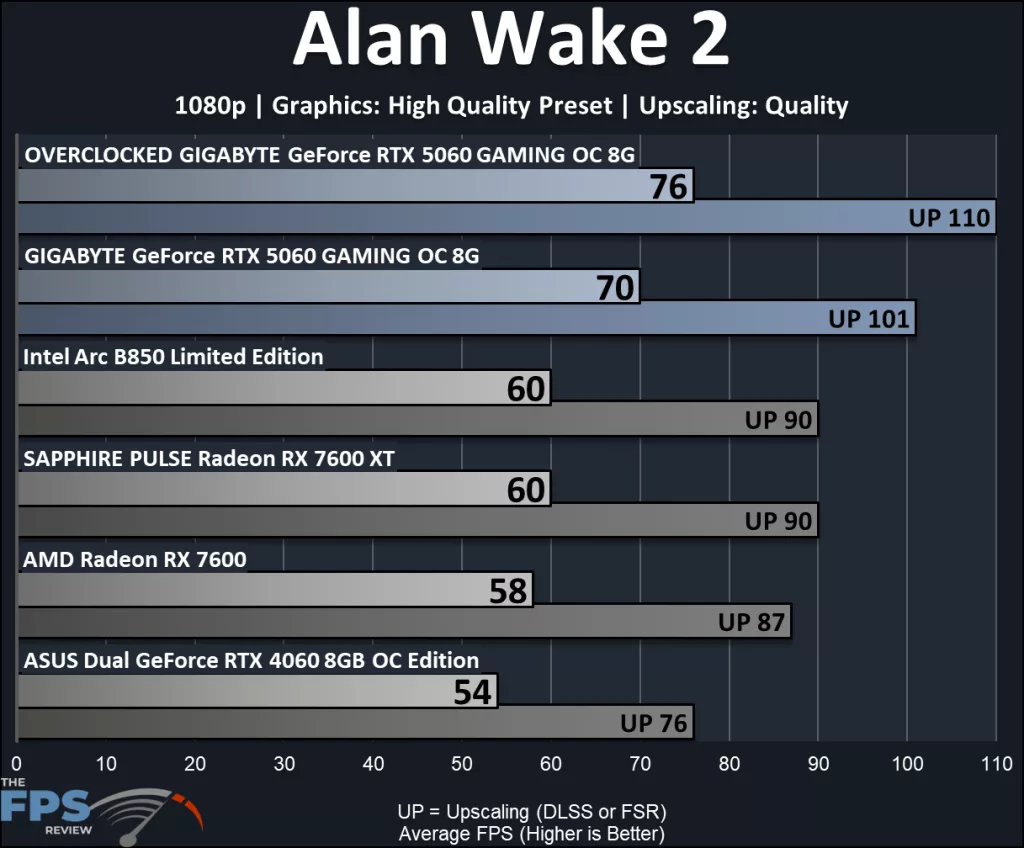
Here, three of five cards are playable natively. The GIGABYTE GeForce RTX 5060 GAMING OC 8G is 20% faster on average, with a 30% margin over the last generation ASUS Dual GeForce RTX 4060 8G OC Edition. Overclocking adds 8.5%. With upscaling, all our cards are playable. Again, the top 4 cards in the graph are quite fast, with the margin of separation at 18% on average. The gameplay is very smooth for the GIGABYTE GeForce RTX 5060 GAMING OC 8G.
Alan Wake 2-Ray Tracing enabled
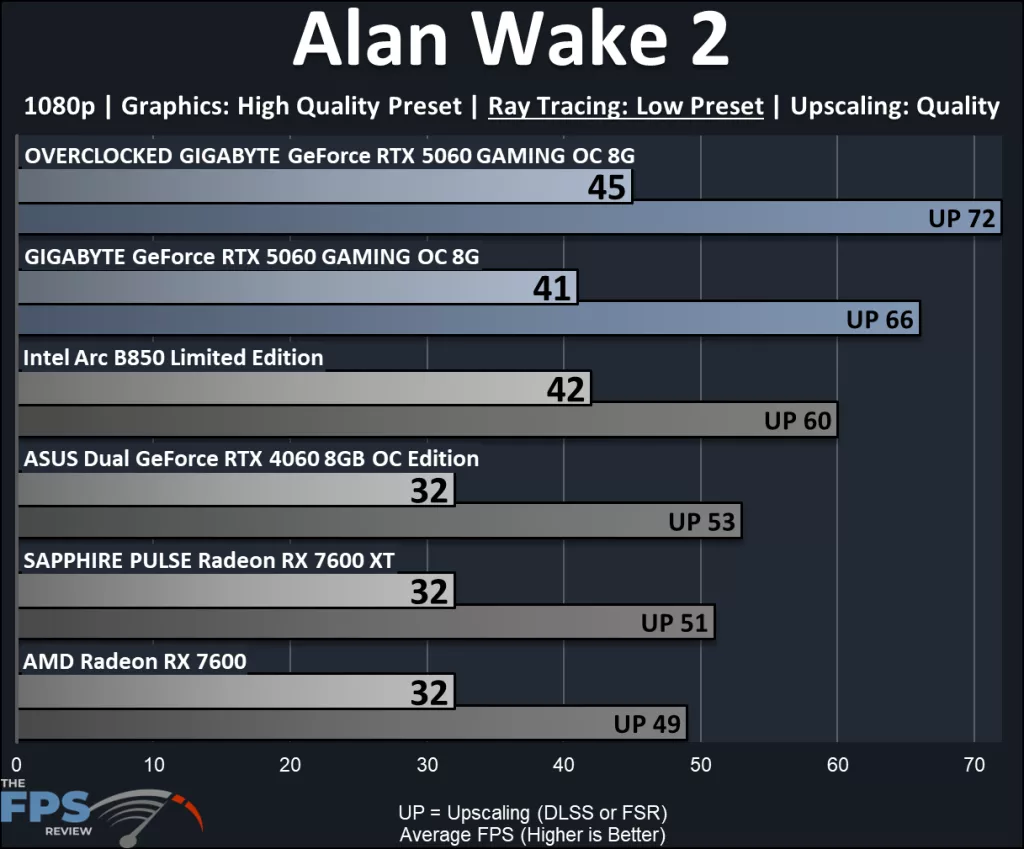
The demands of Ray Tracing, even at “Low”, are obvious. None of the cards are remotely playable. The Intel Arc B580 Limited Edition is actually slightly faster (2%) here. Upscaled the GIGABYTE GeForce RTX 5060 GAMING OC 8G is 10% better than the Intel Arc B580 Limited Edition. The upscale average is skewed by the performance of the slower trio. Overclocking again adds 9%.
Black Myth: Wukong
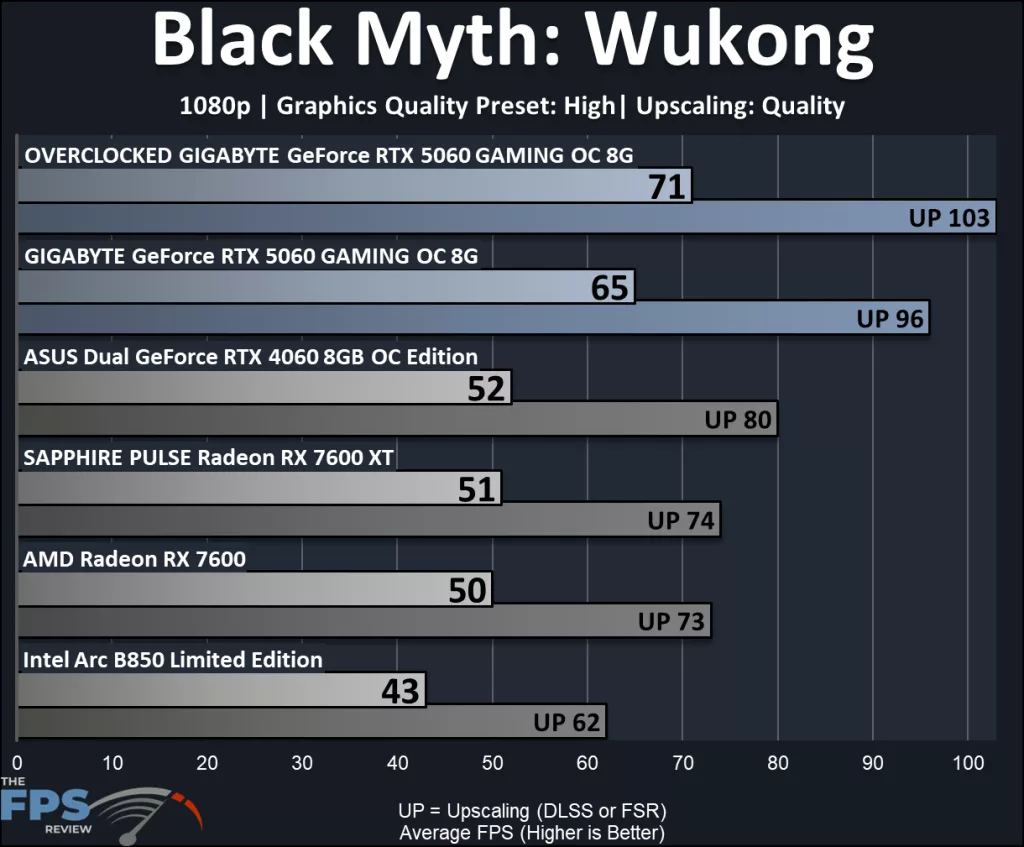
This is one game where we adjusted the settings down a notch. With that, the gameplay was quite good. The GIGABYTE GeForce RTX 5060 GAMING OC 8G was smoothly playable natively, and the only card to accomplish this. The gap over the ASUS Dual GeForce RTX 4060 8GOC Edition was 25% and the average margin was 33% quicker. Overclocking gained 9%. Upscaling was very helpful as all cards were playable. Again, the average margin was skewed by the surprisingly poor performance of the Intel Arc B580 Limited Edition.
Claire Obscur: Expedition 33

Again, we had to adjust down from our usual settings. Only the GIGABYTE GeForce RTX 5060 GAMING OC 8G is playable natively, but very nicely. Without upscaling, the margin over the other cards on average was a whopping 30%. All cards were playable with upscaling, but still with the 30% margin. Overclocking once again gained 9% natively.
Cyberpunk 2077

The performance in this game is very good across the board. The GIGABYTE GeForce RTX 5060 GAMING OC 8G enjoys a 24% faster performance natively with no changes in image settings. Upscaling gives the same margin as well. Overclocking is 9% faster.
Cyberpunk 2007 – Ray Tracing enabled
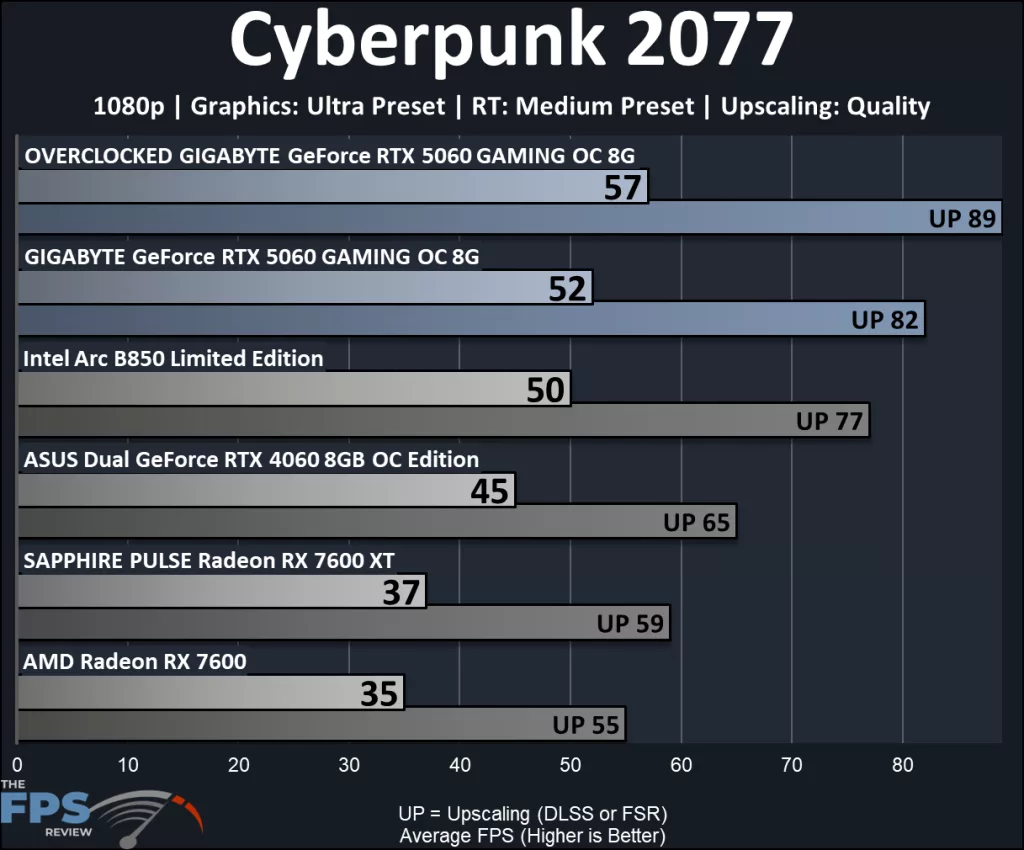
Here we enabled Ray Tracing, but at a lower setting. Even at medium, no cards were playable, a drastic change from the graph above. The struggle gave the GIGABYTE GeForce RTX 5060 GAMING OC 8G a 26% advantage, but still unplayable. Even upscaling left the Radeon cards out of the playable category.
DOOM: The Dark Ages
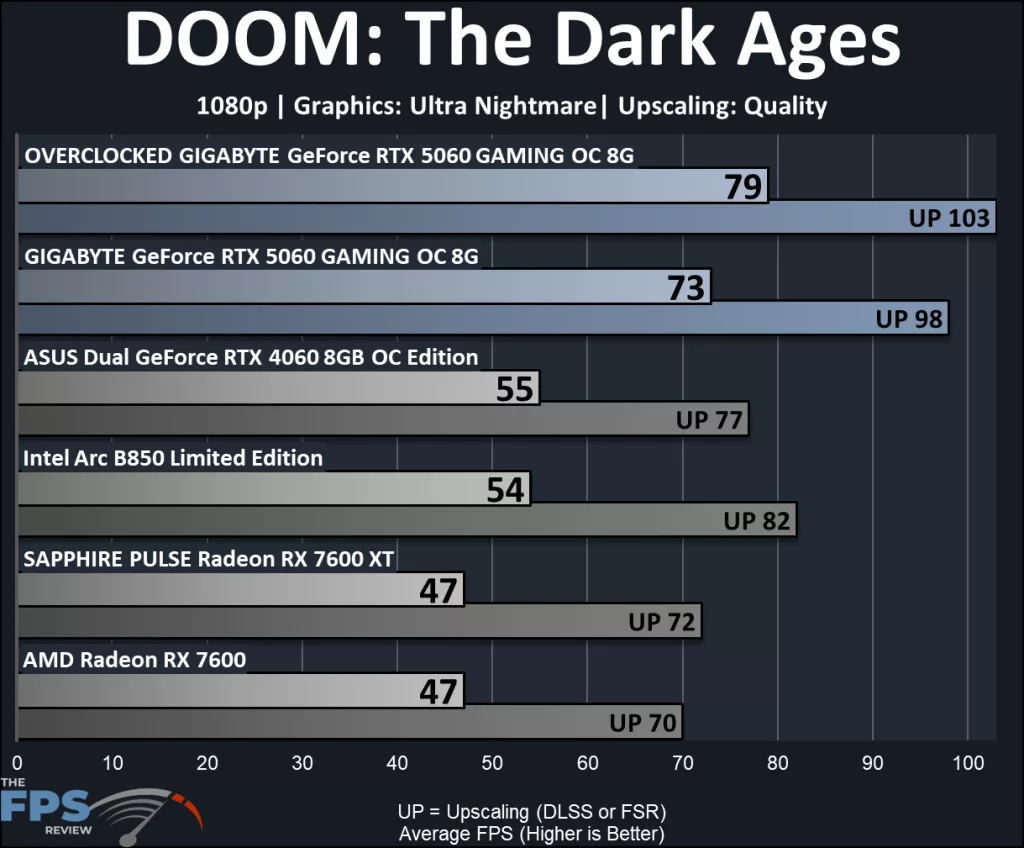
Doom has some always-on ray-traced lighting effects, and all the cards were slowed by this except the GIGABYTE GeForce RTX 5060 GAMING OC 8G. Once again, it was the only playable card without help. The gameplay was quite smooth here, even given the hectic nature of the game. Overall margin 44%. Upscaling helped all cards achieve playable FPS. The GIGABYTE GeForce RTX 5060 GAMING OC 8G was 30% faster. Overclocking gained 8% natively.
Horizon Forbidden West

Results were quite good across the board here. Every card was playable except the AMD Radeon RX 7600. This game, however, was the most obvious of all to demonstrate the effects of limited VRAM. The GIGABYTE GeForce RTX 5060 GAMING OC 8G was playable, but there was obvious hitching and texture loading that did affect the smoothness of the game. Nonetheless, the margin was 21%, but no doubt aided by the slow FPS of the AMD Radeon RX 7600. If the AMD Radeon RX 7600 is removed, the margin is only 12%. The Intel Arc B580 Limited Edition was a mere 4% slower. With upscaling, the results are very similar. Excluding the AMD Radeon RX 7600, the margin shrinks to 9%. Overclocking gained nothing here.
Kingdom Come Deliverance II
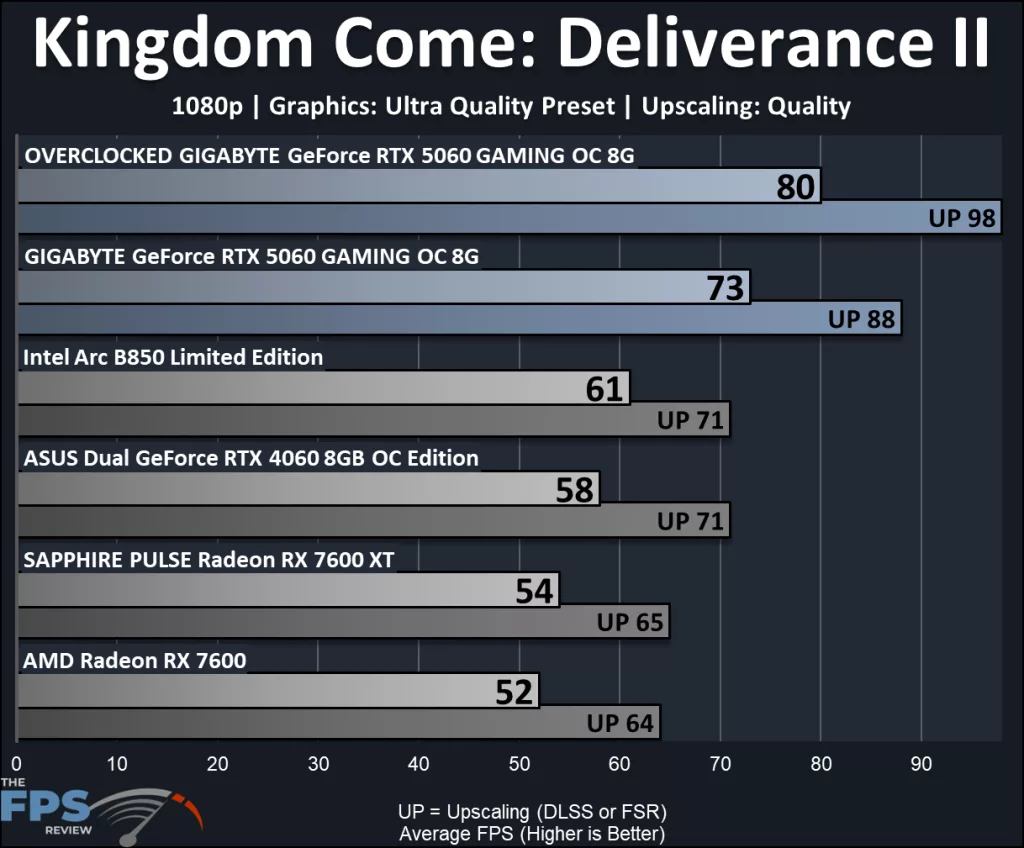
This game is another with always-on ray-traced lighting. Only two cards are playable natively. All cards are playable with upscaling enabled. Overall, the GIGABYTE GeForce RTX 5060 GAMING OC 8G enjoys a margin of 29%. Overclocking gains 10%.
S.T.A.L.K.E.R. 2: Heart of Chornobyl
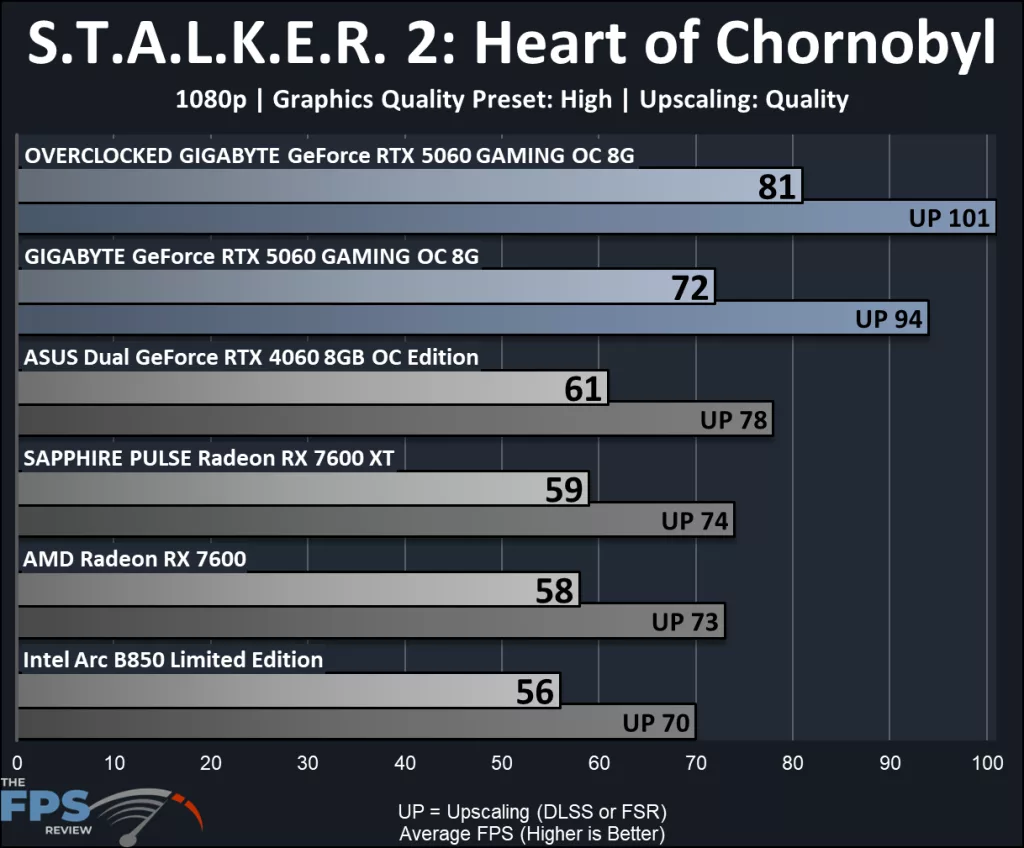
In S.T.A.L.K.E.R. 2, we also adjusted the preset down one notch. Even with that, only 2 cards were technically playable with a tight grouping just below the line. Here, the GIGABYTE GeForce RTX 5060 GAMING OC 8G and the ASUS Dual GeForce RTX 4060 8GOC Edition are the only playable cards natively. The overall average margins are 22% and 27%. Overclocking gains 12%. All cards are quite playable using upscaling.
Star Wars Outlaws

Our final test game is also always on ray tracing. Here, all the cards struggle natively. Only the GIGABYTE GeForce RTX 5060 GAMING OC 8G is playable. The distance on average is 27%. When upscaled, all cards are playable and actually quite smooth. The gap is the same. Overclocking provides an 11% uptick.
